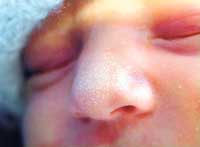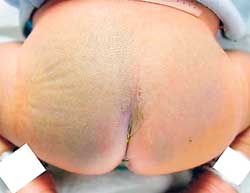
When baby changes colourAny parent would expect their newborn baby to be a pink chubby-cheeked angel. However in reality, this is hardly the case. The newborn's skin is usually dark red or even purplish and sometimes can look quite alarming with deep red patches, pimples like lesions and rashes. Most of them are normal but there are times you need to seek medical advice. MediScene spoke to Dr. Pujitha Wickramasinghe, a consultant paediatrician at the Lady Ridgeway Hospital for Children about these conditions. Usually the newborn skin is red or dark pink in colour but it varies with the baby's age, race or ethnic group, temperature, and whether or not the baby is crying. At birth there can be a blue tinge which disappears once the baby starts to breathe. Bluish discolouration in the tongue or the other parts of the body or if it appears while crying could be an early sign of an illness and requires assessment by a doctor.
"Yellowish discolouration of the baby's skin and the eyes is also another problem that worries mothers," says Dr. Wickramasinghe. This is also called "jaundice". This could be normal provided it is mild and occurs after the second day of life and fades within two weeks. Severe yellowish skin discolouration occurring on the first day or persisting beyond two weeks can be due to sinister problems and medical attention is needed. Other common harmless skin lesions are the presence of vernix, lanugo hair, milia, erythema toxicum, Mongolian spots, strawberry hemangioma and port wine stains. "These are normal conditions which usually go off once the baby grows, hence no medical intervention is needed," explains Dr. Wickramasinghe. Vernix Vernix means the presence of a white greasy substance like a gum on the newborn skin, which gets absorbed within days. Parents are not supposed to try to remove it even when bathing the baby. Lanugo hair This is soft, downy hair on a baby's body, especially on the shoulders, back, forehead, and cheeks. Lanugo hair is usually abundant in the premature baby, whereas in babies born well after the due date, lanugo hair is less. It too goes off with time. Milia These are white hard tiny dots, which appear similar to pimples. Milia are usually seen on the nose and face. This occurs because the glands that moisturize the skin get distended. But is not a disease condition and will disappear without a problem. Erythema toxicum On the second or the third day of life there appear reddish, slightly raised well demarcated areas like flea bites. The baby's skin may appear blotchy. This is common on the cheeks, chest and the back. It too wanes without any consequences. This happens because new born babies’ sweat glands are not well developed and the skin gets heated quickly dilating the blood vessels in the skin. Mongolian spots Large bluish patches with a clear margin that appear on the buttocks and the back are called Mongolian blue spots. "They look similar to bruises, but it's important not to confuse them with bruises," stresses Dr. Wickramasinghe. Within six months to one year, Mongolian spots too fade away. This condition, commonly seen among dark skinned races is essentially benign. Strawberry hemangioma This is a bright or dark red, raised or swollen, bumpy area that looks like a strawberry. Hemangiomas are formed by a concentration of tiny, immature blood vessels. They can occur in any part of the body. They may not appear at birth, but often develop in the first two months. Strawberry hemangiomas are more common in premature babies and in girls. These birthmarks often grow in size for several months, and then gradually begin to fade. Nearly all strawberry hemangioma completely disappear by seven to nine years of age.
If they interfere with the child's vital functions like vision, breathing because of their presence on the face, close to eyes or the nose, treatment may be indicated. Otherwise no intervention is needed. Sometimes following trauma they can bleed. So to prevent this keep baby's nails cut short and if it begins to bleed, apply pressure for some time and seek medical advice. Port wine stains A port wine stain is a flat, pink, red, or purple coloured birthmark. These are caused by a concentration of dilated tiny blood vessels called capillaries. They usually occur on the head or neck. They may be small, or they may cover large areas of the body. They may become darker and may bleed when the child is older or as an adult. Port wine stains on the face may be associated with more serious problems. Skin-coloured cosmetics may be used to cover small port wine stains. The most effective way of treating port wine stains is with a special type of laser. This is done when the baby is older by a plastic surgery specialist. Apart from these conditions, babies could have dry skin. This needs lot of care. Use of proper soap substitutes and application or moisturizing lotions would help to keep the skin healthy. |
|| Front
Page | News | Editorial | Columns | Sports | Plus | Financial
Times | International | Mirror | TV
Times | Funday
Times | Medi Scene || |
| |
Reproduction of articles permitted when used without any alterations to contents and the source. |
© Copyright
2008 | Wijeya
Newspapers Ltd.Colombo. Sri Lanka. All Rights Reserved. |


